Blood Orange Marmalade
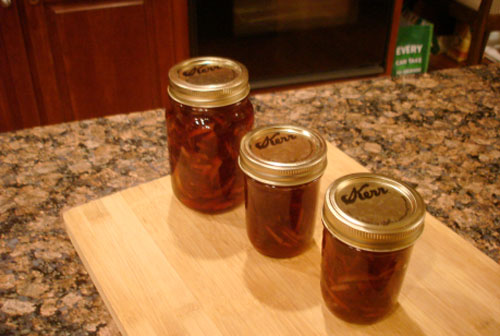
Blood Oranges may sound scary, like something out of a horror movie, but this brightly colored orange is anything but frightening. Most oranges from California and Arizona can be found in markets throughout the year. The Blood Orange however, is only available from January through April. So, there’s not a lot of time to enjoy this sweet and unusual treat.
The Blood Orange seems to have a somewhat secretive past. Citrus experts believe that Blood Oranges are a natural mutation, in which the genetic levels of a sweet orange changed and produced an orange with red-colored flesh, juice and rind. The fruit was so interesting that those who saw it continued to propagate the variety. No one knows exactly where this took place, but most people suspect it was in the Mediterranean.
This very old variety first appeared in Southern Europe around 1850, although blood oranges may have been known of earlier. “Red oranges” were first mentioned in Sicily in the Jesuit Ferrari’s opera Hesperides in 1646. According to his account, these oranges were brought to Italy from the Philippines by a Genovese missionary.
Ferrari’s mention isn’t the only record of blood oranges. They also appear in a painting by the Tuscan artist Bartolomeo Bimbi and in illustrations by the botanist Micheli, both of whom lived in the 17th and 18th centuries.
Blood Oranges were eventually brought to North America by Spanish and Italian immigrants. They are also known as Pigmented oranges, Sanguina, Sanguine, Rubies, Blush or Moro oranges.
Blood Oranges are great eaten fresh, but also make a wonderful morning juice when squeezed fresh, or used in a favorite cocktail like a Sunday Brunch Mimosa or Screwdriver. Try slicing and tossing them in a salad or using them in a chicken marinade where orange juice is called for.
Our favorite treat however, is a Blood Orange Marmalade and when I saw the oranges on our tree show that telltale blush a few weeks ago, all I could think about was making marmalade, but the oranges weren’t quite ripe yet.
Over the last few weeks I’ve checked every few days and today my diligence was rewarded. The oranges on our tree were at the perfect stage of ripeness for making marmalade. These crimson beauties produce a marmalade that is bright, fresh and the flavor bursts when spread on an English muffin or used as a topping on a goat cheese smeared crostini. We also use marmalade in pork and chicken marinade recipes that call for orange marmalade. But that won’t be happening this year because with our afternoon of marmalade making came a slight kitchen disaster that lowered our production by two whole jars. That’s a lot when you start with 10 oranges and the recipe only makes 6 half-pints (more about our mishap later).
The recipe I used came straight out of the Ball Complete Book of Home Preserving, and has become one of our favorite marmalades. I hope it becomes one of your favorites, too!
Here’s how we made our marmalade.
- 3 lbs blood oranges (about 8 oranges)
- 6 cups granulated sugar
Cut off the tops and bottoms of the oranges and score the peel of each orange lengthwise into quarters.
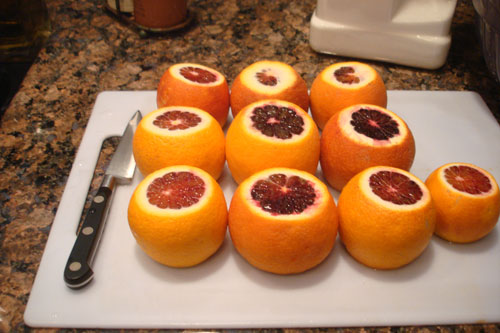
Remove the peel and set the fruit in a bowl to catch all the juice. This can be a little messy and time consuming, but well worth the effort. Place the peel into a large sauce pan and fill with water until just covered. Bring to a boil over medium-low heat and boil for 10 minutes. Cover with more cold water and return to a boil for another 10 minutes or until the peel is softened. Drain.
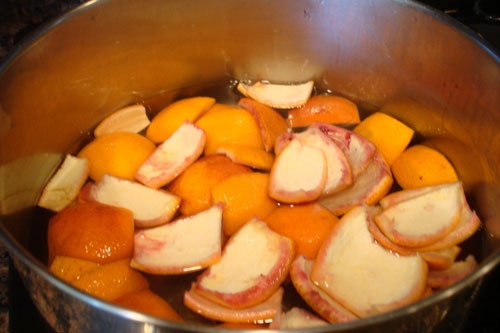
Using a spoon, scrape the pith (the white stuff) from the underneath side of the peel.
Cut the peel into very thin strips (about the matchstick size). Using a sharp paring knife cut the membrane off of the orange segments. Once again, it’s best to do this over a bowl to catch the juice. Place the fruit in a sauce pan. Put membrane in a sieve and using the back of a spoon mash out as much juice as possible. Discard the membrane. Lastly, pour any collected juice into the pan.
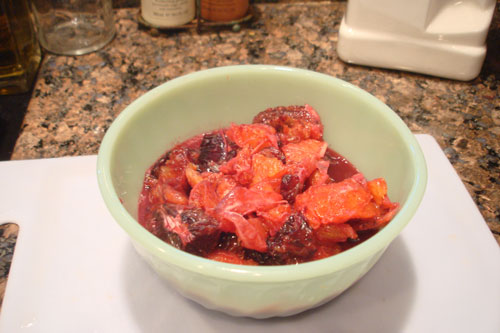
Add the cooked peel and 4 cups of water to the fruit, and bring to a boil over medium-high heat. Reduce the heat and boil gently for about 30-minutes or until the peel is very soft. Remove from the heat and measure 6 cups of the fruit mixture. Add water if necessary to make 6 cups.
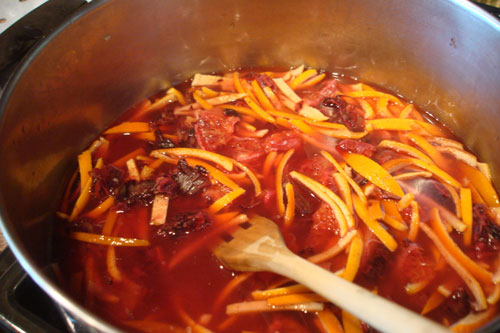
Now, set up your canning supplies; sterilize the canning jars by simmering them in a large pot of water, and boil a few cups of water in a small saucepan for the lids.
In a large stock pot, bring the fruit mixture to a boil over medium-high heat. Gradually add in the 6 cups of sugar, maintaining the boil. Boil hard, stirring constantly, until the mixture reaches the gel stage, about 25-30 minutes. When you reach the gel stage, skim off any foam and ladle the hot marmalade into the hot jars, leaving 1/4″ headspace.
Water bath process for 10 minutes, and then remove the canner lid. Wait 5 minutes before removing the jars. This recipe makes five to six 8-ounce jars unless of course you tip one over while wiping off the rim. Yep…that’s what I did. The jar slipped out of my hand and dumped piping hot marmalade all over the counter, the stove and even down the front of the cabinet. Thank goodness it landed on the kitchen rug or I’d be scraping sticky goo off the wood floors. The major trick was deciding what task to tackle first – the marmalade or the mess – because I was still getting the jars ready for the water bath and if they cooled down too much they could crack in the hot water. All was saved though. The jars got safely into the water bath, the counter, stove and the cabinets got cleaned up before everything hardened. I have to say, it did make an otherwise enjoyable canning experience rather stressful. But, the end result will cherished that much more because of its limited quantity.
Serving Idea:
To accompany the jam start with some French bread and cut them into bruschetta or crostini type shapes. Season with olive oil and salt, bake for 3 minutes at 400 degrees. Remove the bread from the oven and place some blood orange jam and fresh goat’s cheese on the crostinis returning them back to the oven for 3 minutes or until the cheese has started to color. Mix some arugula leaves with olive oil, salt and lemon juice and place on top of the warm crostini.
The jam will hold indefinitely if canned or for at least 4 weeks in the refrigerator. Try it on a buttered English muffin or with a chocolate croissant for breakfast. It’s a great accompaniment to soft cheeses, or try stirring a bit into hot tea.
No matter how you use these crimson beauties they’re bound to become a favorite.
Recent comments
Aenean nonummy hendrerit mauris. Phasellus porta.